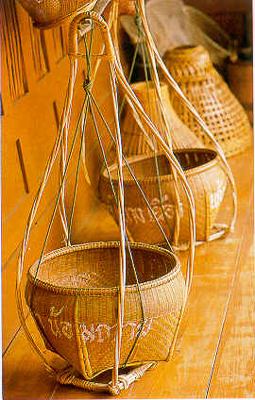|
In northern Thailand, the Ruan Khraung Phook is a temporary house made of leaves of
Bai Tong Tung or Phluang (Dipterocarpus tuberculatus Roxb) amd vetiver grass. The well-known
Ruan Khraung Sap in the north is the Ruan Kalae, which is a style
of construction where twin houses were built on one level. The house itself, though, sits on
high stilts and the top of the gable is decorated with intertwined small pieces of carved wood called Kalae
An original Thai house of the northeastern region is difficult to find nowadays. From
the few that remain, one can see that the Lan Xang culture had a strong influence on this region.
Here, spirits, the worship of ancestirs, and the supposed existence of supernatural entities
had great effect on the daily lives of the populace. Consequently, rites and rituals played an
important role in finding a suitable location for the home, in choosing auspicious kinds of
wood for the house, building dates and procedures, and so on.
The traditional Thai house in the south also has its own unique architectural characteristics.
The southern Pan Ya houses are not raised as high as those of
the central plain or the northeastern parts of Thailand. Instead, they are kept as close to
the ground as possible due to the region's unique architectural adaptation to the climate. Since
the monssons more heavily affect the southern part of Thailand, design differences are
implemented. Support posts are not hammered in the ground, but are rather placed fimly on
foundations made of tough hard wood, stone or cement. One advantage of this construction
technique is that it prevents the house from sinking or collapsing when an excessive amount of
rain softens the ground. Another advantage is that it makes the house the easy to move. In the
southern style, planks are laid lengthwise to minimize the force of the wind, and the roofs display
mixed styles of the gabled roof and the distinctly southern Pan Ya house. The spacious large
open balcony removes any need for air conditioning since the high ceiling allows total air circulation.
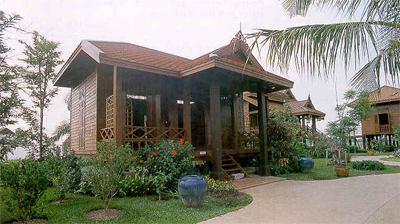
A typical Thai house in southern Thailand is kept close to the ground.
The spacious, open balcony and high ceiling facilitate air circulation
Today, examples of each of the original Thai-style houses can be seen in one location.
Houses from each of the four regions have been built at the Royal Arts and Crafts Center,
Bang Sai District, Phranakhon Si Ayutthaya Province, where Thai heritage and architecture
are well preserved. To enhance the quality and authenticity of the products, and to create a
truly Thai atmosphere, replicas of traditional-style buildings have been constructed on the
center's open-air grounds. These houses, in the Arts and Crafts compound, are exact
replicas of the rapidly disappearing traditional houses of Thailand, which are becoming scarce
due to modernization of the economy and the associated influence of modern architectural
styles and construction techniques.
All Thais are well aware that the Royal Arts and Crafts Center at Bang Sai is not just a
center for Thai arts and crafts but also a fountainhead for their genesis. It was founded under
the gracious patronage of Her Majesty Queen Sirikit and later officially incorporayed into the
Supplementary Occupation and Related Techniques (SUPPORT) Foundation on 21 July 1976.
Since then the foundation has offered craftsmen from all regions of Thailand opportunities
to display their craftsmenship both to the Thai public and visitors from around the world.
Thus, they have gained the well-earned recognition they deserved for their rare skill and expertise.
Since 1976 crafts from this center have gained frequent and favorable attention for Thailand
and its people. Throughout its 24 years of operation, the center has transformed itselt through
the processes of evolutionary development and long-term planning. Early on, a principal
role for the center was the encouragement of the sale of handicrafts created by rural village craftsmen.
Today, through, its role is considerably more sophisticated. Now, the SUPPORT Foundation has evolved
into a highly reputed vocational training center.
|
|
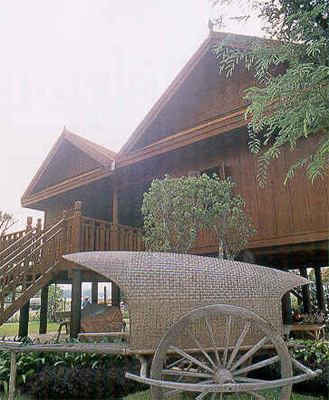
Northeastern Thai-style houses and cart.
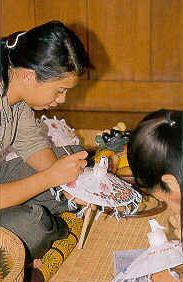
The hand painting of umbrellas is a northern handicraft skill.

Dan Kwian pottery in the northeastern province of Nakhon Ratchasima presents
the contemporary (but crude) style of different shapes and designs.
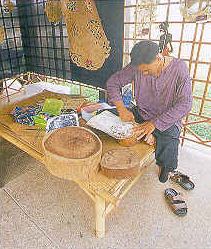
Carving a leather shadow puppet for a shodow play, popular among southern natives.
Cutout leather shadow puppets are one item popular as a shopping attraction.
|



